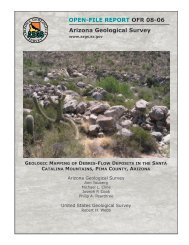geothermal resource potential of the safford-san simon basin, arizona
geothermal resource potential of the safford-san simon basin, arizona
geothermal resource potential of the safford-san simon basin, arizona
You also want an ePaper? Increase the reach of your titles
YUMPU automatically turns print PDFs into web optimized ePapers that Google loves.
The upper basaltic andesite, overlying <strong>the</strong> rhyolite/latite flows in <strong>the</strong><br />
Gila Mountains, is dark gray and occurs in massive flows two to five meters<br />
thick. These rocks are considered equivalent to <strong>the</strong> 20-25 m.y. Bearwallow .<br />
Mountain basaltic andesites <strong>of</strong> Elston and o<strong>the</strong>rs (1973).<br />
Contemporaneous with<br />
this basaltic andesite volcanism, a large rhyolite/latite dome was extruded<br />
in Tollgate Canyon <strong>of</strong> <strong>the</strong> nor<strong>the</strong>rn Peloncillo Mountains ,(D. Richter, pers.<br />
comm.).<br />
Thin unwelded tuffs from this center <strong>of</strong> silicic volcanism are<br />
quarried for cinder.<br />
O<strong>the</strong>r centers <strong>of</strong> silicic volcanism are identified at Dry Mountain in <strong>the</strong><br />
Whitlock Mountains and in <strong>the</strong> Peloncillo Mountains nor<strong>the</strong>ast <strong>of</strong> San Simon.<br />
No thick, extensive sequences <strong>of</strong> welded ash flow tuff are identified in <strong>the</strong><br />
nor<strong>the</strong>rn and central areas <strong>of</strong> <strong>the</strong> Safford-San Simon Basin; <strong>the</strong>refore, no<br />
large Tertiary, cauldron subsidence features are believed to be present.<br />
Also, no thick sequences <strong>of</strong> clastic sediment are interbedded in <strong>the</strong> mid-Tertiary<br />
volcanic sequence that crops out in <strong>the</strong> mountains bordering nor<strong>the</strong>rn<br />
and central portions <strong>of</strong> <strong>the</strong> Safford-San Simon <strong>basin</strong>.<br />
On <strong>the</strong> whole, <strong>the</strong> volcanic<br />
rocks in <strong>the</strong> Gila and Peloncillo mountains dip gently nor<strong>the</strong>ast and have<br />
a total thickness between 0.6 and 1.2 km.<br />
During and after <strong>the</strong> mid-Tertiary volcanism, <strong>the</strong> Pinaleno Mountains "metamorphic<br />
core complex" probably evolved.<br />
"Metamorphic core complexes" may<br />
have formed as a result <strong>of</strong> regional strain, "<strong>the</strong>rmal perturbation, and tectonic<br />
denudation" (Davis and Coney, 1979).<br />
Studies show that core complexes in<br />
sou<strong>the</strong>rn Arizona have a four-element morphology (Davis and Coney, 1979):<br />
(1) unmetamorphosed cover rocks are deformed by listric normal faulting, overturned<br />
folds, and bedding plane faults; (2)<br />
a low-angle decollement zone <strong>of</strong><br />
erosionally resistant, and frequently chlorititized, mylonitic breccia, mylonite,<br />
and microbreccia separates <strong>the</strong> cover rocks from <strong>the</strong> metamorphic carapace;<br />
17

















